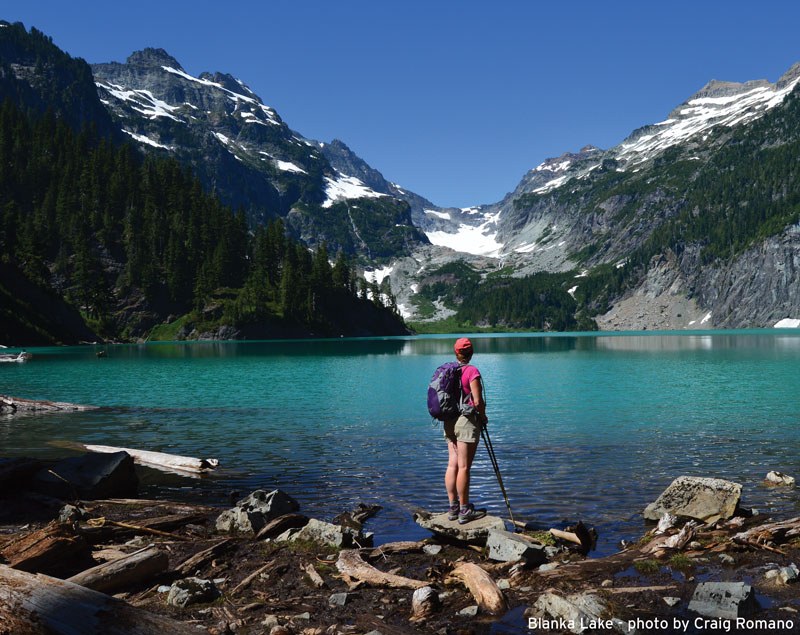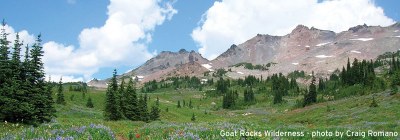
Why are trails so overcrowded these days
Blame the Internet. Blame social media. Blame me and other guidebook writers. Blame the Washington Trails Association (WTA).
Blame a growing population of outdoors recreationists seeking nearby wild places. Or just blame our favorite hiking destinations for being too dammed beautiful! While all of the above might be worthy of blame for the crowding and overuse of several of our favorite hiking destinations, I’d like to spread much of the blame for the crowding at Blanca Lake, Snowgrass Flat, Lake Serene and a handful of other areas on Congress and the President, and some overzealous environmental groups.
First of all, I have always believed that there is plenty of room in our public lands to accommodate the millions of recreationists who take to them annually. While on a hike to the top of Mount San Jacinto in Southern California this May, my belief was reconfirmed. I walked miles of trail without seeing another hiker—and once I reached the 10,834-foot mountain’s lofty summit, I only shared it with a dozen other hikers. Not bad considering that we were within an hour and half drive to 20 million people!
Closer to home
Washington has seven million people and over 11 million acres of National Forest and National Park lands. Over 25% of its land base is national park and forest lands. Add the Bureau of Land Management, National Wildlife Refuges, state parks, Department of Natural Resources (DNR) lands, and state fish and wildlife lands and you have another 6 million plus acres of public land bringing the state’s total of public lands to over 35%. That’s a lot of public land — about 2.4 acres per resident.
So, why does it seem that so many of our favorite hiking spots are being overrun?
Well, because they simply are.
Part of the problem is that, despite there being so much public land in Washington, a large percentage of it is or has been used for resources, like logging, making it less than desirable for outdoor recreation. Another reason is proximity — places closer to metropolitan areas tend to attract more folks merely because they are quick and easy to get to. Of course, some areas are just too darned pretty too that they attract legions of people no matter where they are, and have been since they were discovered. You, me and most hikers prefer to go to the really spectacular places, right? Then again, we know that there are plenty of other spectacular places close and far that are not being overrun by hikers. Why? A big part of the reason is access.
Getting people out - but not out there
This summer a district ranger from one of our state’s national forests sent a memo to the WTA to stop promoting certain destinations because they were becoming too crowded. WTA complied and contacted me about not promoting these same spots on my Hikeoftheweek.com website. We agreed to not make these places the hike of the week or call attention to them for the rest of the season. The irony is that we really want people to get out on the trails. More people hiking means more people caring for our public lands and wanting to protect and expand them — right? And don’t we want our children (and adults) to put down their electronic gadgets and go for a walk?
It’s true that places like Snow Lake, Blanca Lake, and Snowgrass Flats are being overwhelmed — and all this use is compromising their ecological integrity. It’s also compromising the wilderness experiences for many hikers, too. Forget about the 12-person group maximum when there are hordes upon hordes of folks traipsing through the wilderness, right? While environmentally conscious guidebook authors and organizations like the WTA and The Mountaineers emphasize adherence to wilderness rules and regulations and preach Leave No Trace principles, lots of Internet based hiking sources do not. Which leads me to Meetup groups and other social media sites that, through their viral nature, can have hundreds of people trampling on a trail through a wilderness area on any given day. The rise of this phenomenon is certainly to blame for some of our over-crowding and less-than-enlightened trail users.
But I want to blame our federal government and some environmental groups for the overcrowding too. Nowhere is their role in crowding more evident than in the Goat Rocks Wilderness and the Darrington and Skykomish Ranger Districts of the Mount Baker-Snoqualmie National Forest. At the ever-popular Snowgrass Flat Trailhead, the district ranger has posted a sign warning of crowding and suggesting hikers to go elsewhere. There is only one problem with this suggestion — in many cases it’s truly difficult to go elsewhere. Most of the other trailheads leading into the Goat Rocks Wilderness can’t be reached by passenger cars — or reached at all. It doesn’t do much good to suggest that folks hike other trails leading into this sprawling wilderness if they can’t access them due to a deteriorating road system plagued with potholes, rocks, brush and washouts. And if they can get to some of these trailheads, they may find the trails themselves washed out, grown over and fallen into disrepair leading to difficult or impossible traveling.
It’s the same thing over on the Skykomish and Darrington districts. Many trail access roads have been washed out for
years. Trails leading from these undrivable roads are fading back into the wilderness. Who’s to blame? Congress for sure, for not wanting to properly fund the Forest Service. They haven’t wanted to in decades, leaving the Forest Service incapable of doing much in the field. Congress has gutted budgets leaving most districts void of trail crews, road maintenance crews, law enforcement officers, rangers, biologists and visitor services personnel. Since around 1990 the Forest Service has shifted away from resource extraction (which brought money into the treasury) to recreation and forest regeneration. Congress has slashed the budget and tried to bring more funding in through user fees that have never been popular — or adequate. And the president? I blame him too. All of them since President Reagan. Not one of our last five presidents has made the Forest Service — an agency responsible for over 193 million acres of public land — a priority! Sure, President Clinton convened the Northwest Forest Conference which lead to better management (a good thing), but it was also under his watch that the shift to privatizing campgrounds and collecting user fees in lieu of adequate funding began (not such good thing).
I blame overzealous environmental groups too. These groups want to keep many of our Forest Service roads closed to restore ecosystems, while at the same time bemoaning the trampling of ecosystems because there are too many people recreating in them. Yes, many of our old forest roads need to be decommissioned and the lands surrounding them restored. But how misguided some of these organizations are for advocating for the decommissioning of major Forest Service Roads leading to beloved campgrounds and trails
We need more access, not less if we are to accommodate a growing population — and if we are to disperse them so that their impact is light and their outdoor experience is optimal.
Paths less traveled by
I do my best to promote less known places in my writings. WTA does too. But if folks can’t get to those places, they will continue to crowd the places they can get to. Sure, some folks aren’t interested in other options and will continue to go to the same places over and over again. Perhaps then we need to regulate use at some of these areas, like we do in the Enchantments and Mount Margaret Backcountry. But let’s make sure we have lots of other hiking options available first — lest we have a very unhappy hiking constituency that may not support more wilderness and park designations. And let’s hold Meetup groups and other Internet based hiking promoters accountable, too. Know the rules, respect them, and disperse some of your use.
We really need to hold ourselves accountable for not being more active in protecting our interests. There are things we can do to help. We can demand that Congress and the President start treating our public lands like the national treasures that they truly are. We can support organizations that represent our outdoor recreation interests and blend sound conservation practices with adequate trail and public land access. And we can seek out alternative trails every now and then, and realize that Blanca Lake, Lake Serene, and Snowgrass Flat aren’t the only pretty places worth hiking to.
There are thousands of other places to venture. Let’s be the explorers that we are and find them! We just need to make sure we can get to them first.
This article originally appeared in our November/December 2014 issue of Mountaineer magazine. To view the original article in magazine form and read more stories from our bi-monthly publication, click here.
Opinions expressed in these articles are those of the authors and do not necessarily represent the views of The Mountaineers.
Add a comment
Log in to add comments.I truly believe we are loving our trails to death. While it may be a good idea to create easier access to more trails, there is still a need to educate the public on good trail etiquette. It's sad to go places, like Goat Lake, and see wild flowers and ecologically sensitive areas trampled from people who don't have a clue. Those overseeing the national forests should create better signage and better mitigation systems to prevent trail damage. But they're strapped for cash, leaving volunteers to take up the slack. Organizations like WTA and the Mountaineers as well as businesses like REI should step in and help more in this area since they are promoting outdoor use and helping to encourage more people to "get outside." It's not just about getting outside, it's also about getting outside and being a good steward of the environment.
 Craig Romano
Craig Romano
